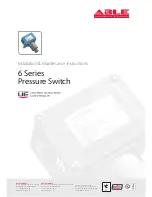
Introduction
The CurrentWatch™ ECS7 Series current
switches are designed for overload,
underload or operating window applications.
Upon sensing an average operating current,
the ECS7 Series self-learns and establishes a
limit-alarm trip point based on plus or minus
15 percent of the average expected current
being monitored. The ECS7 Series is available
in solid or split core housing styles.
The ECS7 Series magnetically isolated solid state output contacts
are rated for 0.30 A @ 135 VAC/DC. This “universal” output makes
this product especially well suited for PLC control systems or a vari-
ety of load connections.
Eaton’s current sensor family encompasses a broad range of
products for cost-effective monitoring, status, and predictive main-
tenance. Downtime and costly repairs can be avoided by utilizing
Eaton’s products and technology in your control systems.
Note:
N
Unless otherwise specified, the term “load” refers to the current being
monitored.
Installation
Considerations for all ECS7 Series models…
•
Run wire to be monitored through the aperture (opening) in the
switch body.
•
These switches can be located in the same environment as
motors, contactors, heaters, pull-boxes and other electrical enclo-
sures.
•
Mounting can be done in any position or hung directly on a wire
with a wire tie.
•
Be sure to leave at least 1.0 in. (25.4 mm) distance between sen-
sor and other magnetic devices.
Considerations for split-core models only…
•
Press the tab in the direction
shown in the diagram to the right.
•
After placing the wire in the
aperture, press the hinged portion
firmly downward until a click is
heard and the tab pops out fully.
•
Keep split-core contact areas
clean. Silicon grease is factory applied on the mating surfaces to
prevent rust and improve performance. Be careful not to allow
grit or dirt into the grease in the contact area, particularly on core
mating surfaces of split core models. Sensor operation could be
impaired if mating surfaces do not have good contact. Check visu-
ally before closing.
Quick Install Guide
The below steps can be followed to quickly install a CurrentWatch
ECS7 Series switch.
1. Run the wire to be monitored through the aperture.
2. Mount the sensor.
3. Connect output wire to the solid state relay terminals:
a. Use up to 14 AWG copper wires,
b. Don’t exceed output rating.
4. Slide the Function Switch from “CLR” to “RUN”.
5. Turn load “On”, equipment is now energized and sensor is cali-
brated.
Note:
N
Refer to the LED Indication table on page two for switch operation.
To open:
Press tab inward
towards hinge
Important:
Keep contact areas clean
AC or DC
Electrical Equipment Load
AC or DC
Power
Monitored
Wire
Use caution when
switching lamps
Wiring Diagram
Connect control or monitoring wires to the sensor. Use up to 14
AWG copper wire and tighten terminals to 7 in.-lbs / 0.79 N·m maxi-
mum torque. Be sure the output load does not exceed the solid
state output rating
.
CAUTION
INCANDESCENT LAMPS CAN HAVE “COLD FILAMENT INRUSH” CURRENT OF
UP TO TEN TIMES THEIR RATED AMPERAGE. USE CAUTION WHEN SWITCHING
LAMPS.
Setpoint Adjustment
The CurrentWatch ECS7 Series has an internal microprocessor that
“learns” your load characteristics and calibrates the setpoint and
setpoint window.
Inioial CalibraoiNn
1. This product is shipped from the factory with Function Switch in
the “CLR” position, which clears the memory.
2. After installation is complete and the output is connected prop-
erly, slide this switch into the “RUN” position.
3. Turn on the load. The LED indicator marked “CALIB/ALARM”
will flash slowly (about one flash every two seconds) during the
learning period. When this LED goes out, the sensor has been
calibrated.
Rt-CalibraoiNn
If the load or conditions change, you may need to recalibrate the
sensor. Below are the steps for doing so.
1. Safety first — turn load power off before recalibrating.
2. Slide the Function Switch to the “CLR” position.
3. Turn the load power back on for five seconds, then turn it off.
This clears the memory.
4. Slide the Function Switch to the “RUN” position.
5. Turn the load back on. The sensor is now re-calibrated.
Note:
N
For special situations, re-calibration can be performed while the load
is running. Exercise extreme caution when placing your hands into a high
voltage environment! With the load running, flip the Function Switch to the
“CLR” position, wait five seconds, then move the Function Switch back to the
“RUN” position. The sensor will then re-calibrate.
LED Indication
State
Contact LED
Calibration LED
Off
Load off or below threshold.
Caution! Load power may
be on!
Sensor is operating nor-
mally or is off.
Slow Flash
(Once Every Two
Seconds)
See graph on next page.
Sensor is learning the
load and self-calibrating.
Fast Flash (About
Two Flashes Per
Second)
See graph on next page.
Calibration error. Perform
re-calibration.
2
EATON
www.eaton.com
CurrentWatch™ ECS7 Series Current Switches
Self-Calibrating AC Current Switches
with Solid State Outputs
Instructions Publication
P51922
Effective July 2017






















